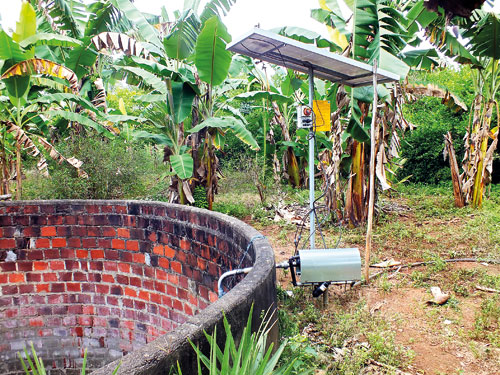Government very slow in approving viable solar power projects

File picture of solar power used to irrigate papaya plantations
As government looks to boost solar power units to meet the growing power demand in the country, investors are not too keen to invest in mega solar power plants anymore. Why? Because of a lethargic attitude and delays in decision-making by the Government in approving projects.
Currently, the government seems to focus more on LNG and coal based power plants although it has launched a âbattle for solar energyâ that aims to add 220 megawatts of clean power to the countryâs energy grid by 2020, or about 10 percent of the countryâs current daily electricity demand, several investors said.
By 2025, the country hopes to boost its solar power output to 1,000 megawatts to meet fast-growing power needs.
Solar power has the potential to meet 32 per cent of Sri Lankaâs annual power demand of around 10,500 gigawatts â but so far just 0.01 per cent of that potential has been developed, according to the Sri Lanka energy sector development plan for 2015-2025.
One of the projects delayed is by Energeia Asset Management (EAM), a company based in Norway, which has made a proposal to the government to establish EAM Solar SL Plc investing between US$ 400 million and $1.2 billion in solar energy-generating infrastructure, bringing several benefits.
Their plan aims at delivering long-term electricity at a price cheaper than coal, reducing the cost of generating electricity in Sri Lanka by more than 8 per cent, reduce future CO2 emission with more than 2 million tonnes annually and achieve an accumulated reduction in the cost of imported fossil fuel by between $ 2 billion and 6 billion over the next 20 years.
The only requirement EAM has in order to execute the investment is that the government enters into a long-term power purchase agreement (PPA) at commercially viable terms like a long-term real purchase price between Rs 10 and 14 per kWh electricity delivered into the electricity grid (subject to negotiations), they revealed.
In this context a feasibility study was made by EAM in conjunction with a possible establishment of an investment company that will invest in utility scale solar PV power plants in Sri Lanka, effectively establishing a large solar PV utility company to the long-term benefit of Sri Lanka and all stakeholders in the company.
Furthermore, Energeia Asset Managementâs intention is to make the ownership of such a utility a publicly available investment opportunity, open to anyone to invest and participate in creating sustainable, clean and renewable energy production, with good returns on invested capital, by making the shares of the company freely tradable and list the companyâs shares in London and Colombo, officials of the company disclosed.
The feasibility study was conducted from April 2012 until November 2013 and it was based on public available information and meetings conducted with representatives of the Government and key stakeholders relevant for establishment of such an enterprise.
A sum of around $300,000 was spent for the feasibility study and a comprehensive report was submitted to the then Government and it was also forwarded to the present government authorities as well.
But there was no indication whatsoever from the Power and Renewable Energy Ministry although the EAM is ready to go ahead with the project proposal at any time, Christian Hagemann, Chief Operating Officer of EAM told the Business Times in a conference call from Oslo on Wednesday night.
He noted that EAM is just one entity among many in the international community that currently looks forward to an open and transparent process when it comes to such timely, forward thinking and progressive large scale projects which will benefit Sri Lanka and all her citizens whilst progressively driving the country forward.
âNo international investor will consider investing unless the risk and a bankability structure are well and truly in place for such investment. By not facilitating such investors, the price of capital will remain high for Sri Lanka,â he emphasised.
âSolar will provide the lowest cost energy for Sri Lanka for the next 100 years,â he revealed.
Darshan Maralanda, Director, Compass Synergies Pvt Ltd, local associate of the Norwegian company, told the Business Times that Sri Lanka could be an exporter of electricity reversing the flow on foreign currency balance.
He said in fact EAM had a plan to transmit excess solar power to India generating foreign exchange revenue for the country.
The PV solar system cost has reduced the needed long-term Power Purchase Agreement price with approximately 30 per cent to a range of Rs. 7 to 10 per kWh.


